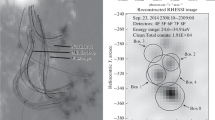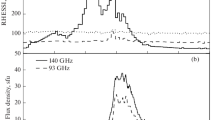Abstract
In this paper, we propose that the accelerated electrons in the quiet Sun could collide with the solar atmosphere to emit Hard X-rays (HXRs) via non-thermal bremsstrahlung, while some of these electrons would move upwards and escape into the interplanetary medium, to form a superhalo electron population measured in the solar wind. After considering the electron energy loss due to Coulomb collisions and the ambipolar electrostatic potential, we find that the sources of the superhalo could only occur high in the corona (at a heliocentric altitude \({\gtrsim}\,1.9~\mathrm{R}_{\odot}\) (the mean radius of the Sun)), to remain a power-law shape of electron spectrum as observed by Solar Terrestrial Relations Observatory (STEREO) at 1 AU near solar minimum (Wang et al. in Astrophys. J. Lett. 753, L23, 2012). The modeled quiet-Sun HXRs related to the superhalo electrons fit well to a power-law spectrum, \(f \sim \varepsilon^{-\gamma}\) in the photon energy \(\varepsilon\), with an index \(\gamma\approx2.0\,\mbox{--}\,2.3\) (3.3 – 3.7) at 10 – 100 keV, for the warm/cold-thick-target (thin-target) emissions produced by the downward-traveling (upward-traveling) accelerated electrons. These simulated quiet-Sun spectra are significantly harder than the observed spectra of most solar HXR flares. Assuming that the quiet-Sun sources cover 5 % of the solar surface, the modeled thin-target HXRs are more than six orders of magnitude weaker than the Reuven Ramaty High Energy Solar Spectroscopic Imager (RHESSI) upper limit for quiet-Sun HXRs (Hannah et al. in Astrophys. J. 724, 487, 2010). Using the thick-target model for the downward-traveling electrons, the RHESSI upper limit restricts the number of downward-traveling electrons to at most \({\approx}\,3\) times the number of escaping electrons. This ratio is fundamentally different from what is observed during solar flares associated with escaping electrons where the fraction of downward-traveling electrons dominates by a factor of 100 to 1000 over the escaping population.




Similar content being viewed by others
References
Aschwanden, M.J., Tarbell, T.D., Nightingale, R.W., Schrijver, C.J., Title, A., Kankelborg, C.C.: 2000, Astrophys. J. 535, 1047. DOI .
Brown, J.C.: 1971, Solar Phys. 18, 489. DOI .
Chandrasekhar, S.: 1960, In: Radiative Transfer, Dover, New York, ISBN 0-486-60590-6.
Edwards, P.J., McCracken, K.G.: 1967, J. Geophys. Res. 72, 1809. DOI .
Feffer, P.T., et al.: 1997, Solar Phys. 171, 419. DOI .
Freeland, S.L., Handy, B.N.: 1998, Solar Phys. 182, 497. DOI .
Grefenstette, B.W., et al.: 2016, The first focused hard X-ray images of the Sun with NuSTAR. Astrophys. J. submitted.
Hannah, I.G., Hudson, H.S., Hurford, G.J., Lin, R.P.: 2010, Astrophys. J. 724, 487. DOI .
Hannah, I.G., et al.: 2016, Astrophys. J. Lett. 820, L14. DOI .
Harrison, F.A., et al.: 2013, Astrophys. J. 770, 103. DOI .
Haug, E.: 1975, Z. Naturforsch. 30, 1099.
Haug, E.: 1997, Astron. Astrophys. 326, 417.
Holt, S.S., Ramaty, R.: 1969, Solar Phys. 8, 119. DOI .
Hurford, G.J., Mewaldt, R.A., Stone, E.C., Vogt, R.E.: 1974, Astrophys. J. 192, 541. DOI .
Kim, S., et al.: 2015, Astrophys. J. 806, 32. DOI .
Koch, H.W., Motz, J.W.: 1959, Rev. Mod. Phys. 31, 920. DOI .
Kontar, E.P., Brown, J.C.: 2006, Adv. Space Res. 38, 945. DOI .
Kontar, E.P., Jeffrey, N.L.S., Emslie, A.G., Bian, N.H.: 2015, Astrophys. J. 809, 35. DOI .
Krucker, S., Kontar, E.P., Christe, S., Lin, R.P.: 2007, Astrophys. J. 663, 109. DOI .
Leblanc, Y., Dulk, G.A., Bougeret, J.-L.: 1998, Solar Phys. 183, 165. DOI .
Lemaire, J.F.: 2011. arXiv .
Lin, R.P.: 1974, Space Sci. Rev. 16, 189. DOI .
Lin, R.P.: 1998, Space Sci. Rev. 86, 61. DOI .
Lin, R.P., Hudson, H.S.: 1971, Solar Phys. 17, 412. DOI .
Lowder, C., Qiu, J., Leamon, R., Liu, Y.: 2010, Astrophys. J. 783, 142. DOI .
Mandelshtam, S.L.: 1965, On the X-ray radiation of the quiet sun. Ann. Astrophys. 28, 614.
Pan, L., Lin, R.P., Kane, S.R.: 1984, Solar Phys. 91, 345. DOI .
Parker, E.N.: 1988, Astrophys. J. 330, 474. DOI .
Peterson, L.E., Schwartz, D.A., Pelling, R.M., McKenzie, D.: 1966, J. Geophys. Res. 71, 5778.
Ramaty, R.: 1986, In: Sturrock, P.A., et al. (eds.) Physics of the Sun, Reidel, Dordrecht, 291.
Schmelz, J.T., Pathak, S., Dhaliwal, R.S., Christian, G.M., Fair, C.B.: 2014, Astrophys. J. 795, 139. DOI .
Shimojo, M., Shibata, K.: 2000, Astrophys. J. 542, 1100. DOI .
Takakura, T.: 1969, Solar Phys. 6, 133. DOI .
Takakura, T., Kai, K.: 1966, Publ. Astron. Soc. Japan 18, 57.
Tian, H., et al.: 2014, Astrophys. J. Lett. 790, L29. DOI .
Wang, L., et al.: 2006, Geophys. Res. Lett. 33, L3106. DOI .
Wang, L., et al.: 2012, Astrophys. J. Lett. 753, L23. DOI .
Wang, L., et al.: 2015, Astrophys. J. Lett. 803, L2. DOI .
Yang, L., et al.: 2015, Res. Astron. Astrophys. 15, 348. DOI .
Yoon, P.H.: 2011, Phys. Plasmas 18, 122303. DOI .
Yoon, P.H.: 2012, Phys. Plasmas 19, 052301. DOI .
Yoon, P.H., et al.: 2012a, Phys. Plasmas 19, 102303. DOI .
Yoon, P.H., et al.: 2012b, Space Sci. Rev. 173, 459. DOI .
Acknowledgements
We thank Gordon Holman, Rui Liu, and Eduard Kontar for helpful discussions. This research at Peking University is supported in part by NSFC under contracts 41421003, 41274172, 41474148, 41231069. I.G. Hannah acknowledges support from a Royal Society University Research Fellowship. S. Krucker is supported by Swiss National Science Foundation (200021-140308) and through NASA contract NAS 5-98033 for RHESSI.
Author information
Authors and Affiliations
Corresponding author
Rights and permissions
About this article
Cite this article
Wang, W., Wang, L., Krucker, S. et al. Simulation of Quiet-Sun Hard X-Rays Related to Solar Wind Superhalo Electrons. Sol Phys 291, 1357–1367 (2016). https://doi.org/10.1007/s11207-016-0916-z
Received:
Accepted:
Published:
Issue Date:
DOI: https://doi.org/10.1007/s11207-016-0916-z




